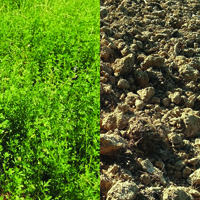Soil N2O emissions after perennial legume termination in an alfalfa-wheat crop rotation system under Mediterranean conditions

Accepted: 30 June 2020
HTML: 11
All claims expressed in this article are solely those of the authors and do not necessarily represent those of their affiliated organizations, or those of the publisher, the editors and the reviewers. Any product that may be evaluated in this article or claim that may be made by its manufacturer is not guaranteed or endorsed by the publisher.
Agricultural activities are potential sources of greenhouse gas (GHG) emissions, and nitrous oxide (N2O) is one of the most important non-carbon-dioxide GHGs. Perennial legumes such as alfalfa (Medicago sativa L.) have potential roles for reduction of soil GHG emissions as part of crop rotation systems. However, the implications of perennial legume termination by tillage and subsequent soil incorporation of the residues for reduced GHG emissions have been poorly examined in Mediterranean environments. With the aim to assess the magnitude of soil N2O emissions (important for the definition of mitigation strategies) after perennial legume termination in alfalfa-wheat crop rotation systems in a Mediterranean environment, we defined the hypothesis that alfalfa termination by tillage with incorporation of the crop residues will increase soil N2O emissions during the subsequent wheat season. To test this hypothesis, closed static chambers were used in a field–plot experiment, using a complete randomised block design with three replicates. Soil N2O emissions were monitored across 33 sampling dates from October 2017 to July 2018, as a comparison between an original 6-year-old alfalfa field (‘continuous alfalfa’) and alfalfa termination followed by wheat (‘alfalfa+ wheat’). The soil N2O emission fluxes varied markedly across the treatments and throughout the monitoring period (from – 0.02±0.01 to 0.53±0.14 g N-N2O ha–1 h–1, and from 0.02±0.07 to 0.37±0.11 g N-N2O ha–1 h–1 for continuous alfalfa and alfalfa+wheat, respectively), generally following the changes in soil temperature. Several soil N2O emission peaks were recorded for both treatments, which mainly coincided with rainfall and with increased soil water content. In the 2 months following alfalfa termination, alfalfa+wheat showed higher cumulative weekly soil N2O emissions compared to continuous alfalfa. Following alfalfa termination for alfalfa+wheat, the increased cumulative weekly soil N2O emissions appeared to be due to asynchrony between nitrogen (N) released into the soil from mineralisation of the alfalfa residues and N uptake by the wheat. Despite these initial high soil N2O emissions for alfalfa+wheat, the seasonal cumulative soil N2O emissions were not significantly different (0.77±0.09 vs 0.85±0.18 kg N-N2O ha–1 for continuous alfalfa and alfalfa+wheat, respectively). These data suggest that legume perennial crop termination in alfalfa–wheat rotation systems does not lead to significant loss of N2O from the soil. The alfalfa termination by tillage performed in autumn might, on the one hand, have slowed the mineralisation process, and might, on the other hand, have synchronised the N release by the mineralised crop residues, with the N uptake by the wheat reducing the soil N2O emissions.
Highlights
- Soil N2O emissions peak after alfalfa termination and rainfall.
- Soil N2O emissions increase after spring alfalfa mowing.
- Seasonal cumulative soil N2O emissions are similar for alfalfa and alfalfa followed by wheat.
- Mitigation effects of perennial legume on soil N2O emissions are not lost after termination by tillage under alfalfa-wheat rotation.
How to Cite
PAGEPress has chosen to apply the Creative Commons Attribution NonCommercial 4.0 International License (CC BY-NC 4.0) to all manuscripts to be published.

 https://doi.org/10.4081/ija.2020.1613
https://doi.org/10.4081/ija.2020.1613







